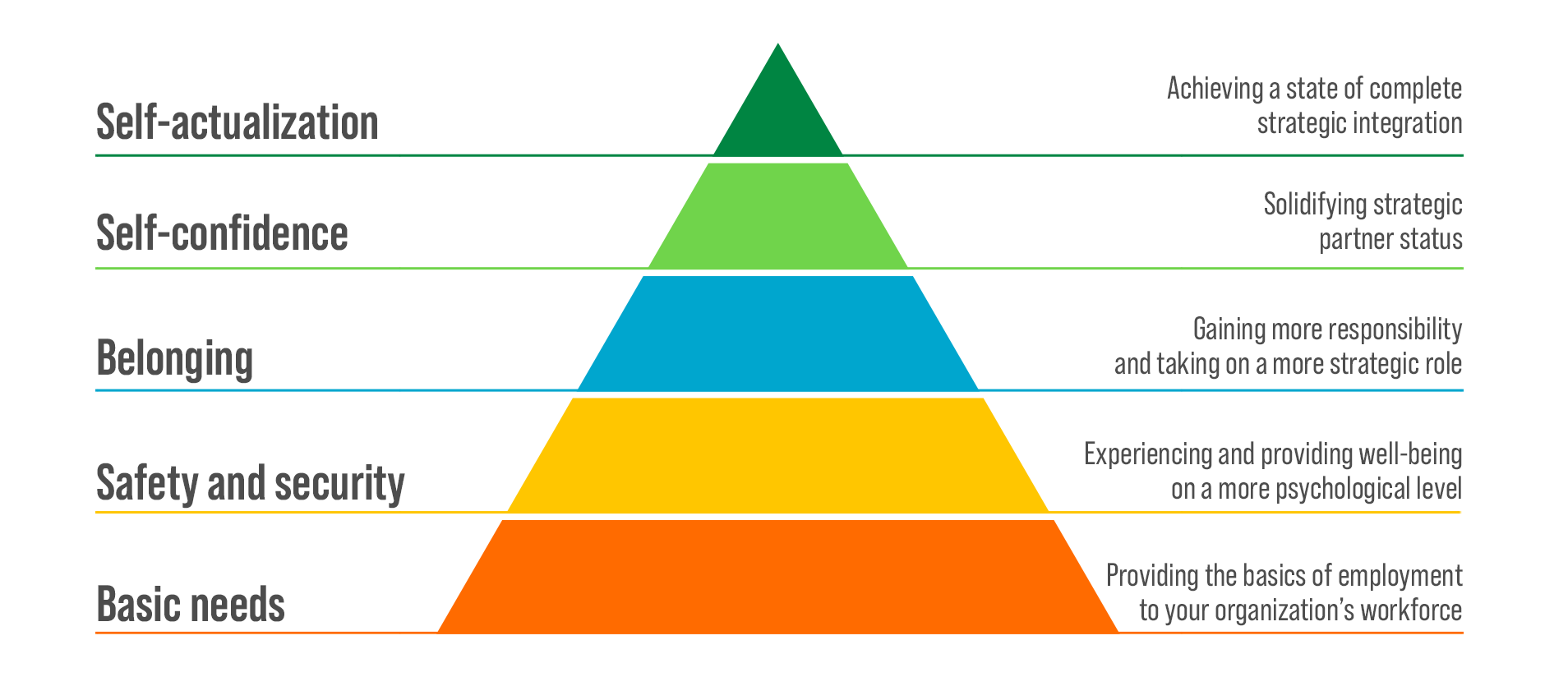In 1943, Abraham Maslow published a paper devising a hierarchal ordering of universal human needs. Popularly expressed in the form of a pyramid, it includes:
- basic needs — think food and shelter — at the bottom
- psychological needs, like social belonging and validation in the middle
- self-fulfillment or self-actualization at the top
You might be asking yourself how this applies to HR. Part of the beauty of Maslow’s concept is its applicability to multiple realms of human endeavor, including the professional world. HR is no exception!
Keeping that in mind, let’s delve deeper into the hierarchy of needs as it might apply to your career.
Basic needs
Think of any regular office job. Now envision its most fundamental requirements — in effect, the office-based equivalent of ready access to food and water.
At this most basic of levels, HR helps employees meet needs that are equally essential. Beyond desks, chairs and computers, these might include:
- a means of onboarding new employees, including the completion of necessary paperwork
- a timekeeping and payroll system, so employees can clock in and out and receive reliable, correct compensation
- a way for eligible employees to select benefits (at least including the basics, like health coverage)
Understandably, HR professionals who exist at this level might yearn to feel more useful.

Safety and security
After physical comfort is taken care of, we enter much more psychological territory. Employees feel secure when they know they’re providing valuable services to their employer.
HR professionals at this stage not only help their organization’s employees experience this level of security; they also experience it themselves. Their work now touches on — or directly involves — areas of greater organizational significance, including:
- helping maintain compliance
- generating reports on vital trends
- facilitating safety, anti-harassment and anti-bullying training for employees
However, as with basic needs, this type of work is liable to lead to a sense of being stuck in a routine. So HR professionals at this stage might find themselves losing sight of the top of the pyramid.
Belonging
The middle of the pyramid provides much more of a psychological safety net. As HR professionals contribute to non-HR employees’ sense of growth and belonging, they experience a higher degree of growth and belonging, too.
In practice, this might mean greater HR involvement in activities like:
- team-building exercises
- employee surveys
- skip-level meetings
- performance discussions
This stage is likely to involve a closer relationship with C-suite leadership, who value HR’s perspective (because you have proven it to be valuable). Picture a forward-thinking company with a firm grasp on the significance of the digital transformation of the workplace and you will be close to the mark.

Self-confidence
At this point, HR has fully cemented itself as a strategic partner, especially in relation to the C-suite. An HR professional at this stage is likely engaged in activities that not only help the organization achieve its purpose, but also define what that purpose is in the first place. These might include:
- coaching and mentoring
- long-term career development planning
- diversity, inclusion and belonging initiatives
- starting to drive the digital transformation
But there is still a little further to go before reaching the top.
Self-actualization
Elusive though it may be, a point of self-actualization is possible in work as in life. For HR professionals, this may mean achieving a state of complete integration into the strategically focused heart of the organization — essential to C-suite, instrumental in the creation of a value proposition to employees and necessary to the execution of an effective talent-management strategy.
There is much potential here for HR pros to take ownership of the digital transformation — that is, 100% employee usage of an HR platform. Also, keep in mind the importance of key performance indicators, including metrics for recruiting and retention, employee usage and leadership development, all of which will gain momentum as the organization knocks out goal after goal.

What does this mean for you?
There are two major takeaways to keep in mind. The first is the sheer fluidity of the hierarchy: HR professionals can (and do) move from one stage to another on a regular basis! So if you’re feeling stuck at a certain level, keep in mind this doesn’t have to be permanent.
The second is that HR professionals may perceive themselves to be at one place on the hierarchy while various other factors suggest they are really on another.
Read our white paper to learn how providing employees with what they want helps them climb the hierarchy of needs.
Disclaimer: The information provided herein does not constitute the provision of legal advice, tax advice, accounting services or professional consulting of any kind. The information provided herein should not be used as a substitute for consultation with professional legal, tax, accounting or other professional advisers. Before making any decision or taking any action, you should consult a professional adviser who has been provided with all pertinent facts relevant to your particular situation and for your particular state(s) of operation.
